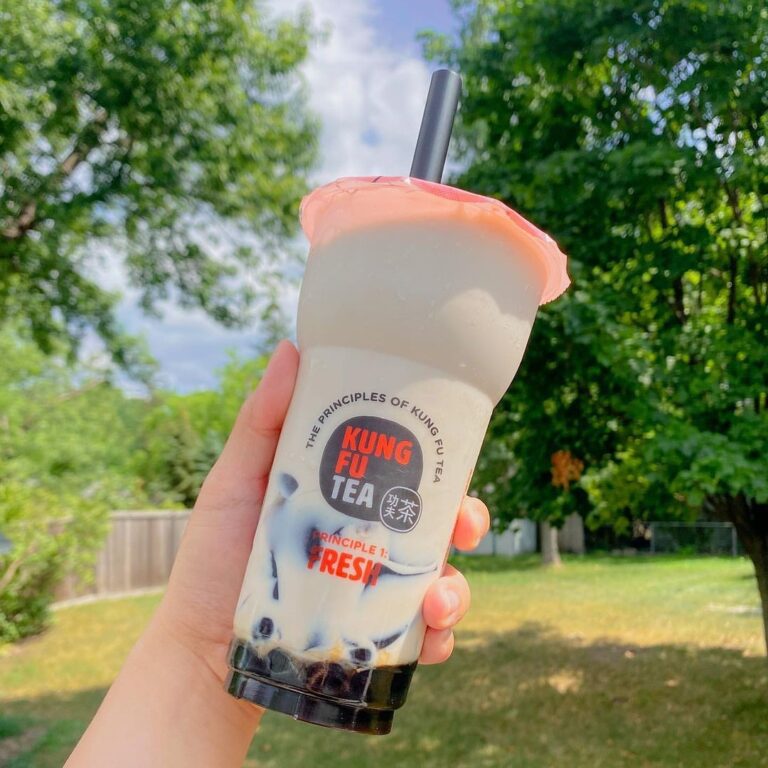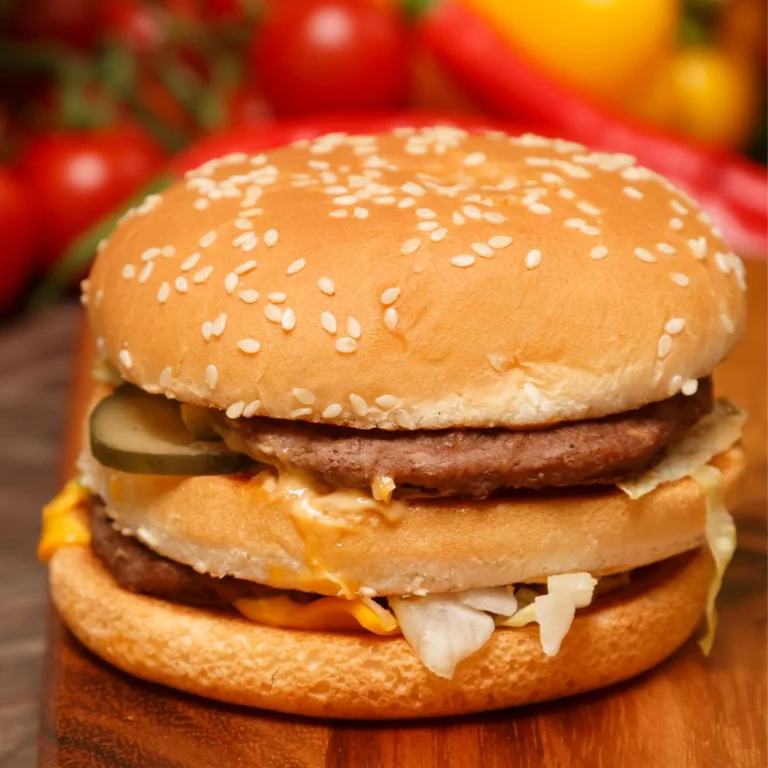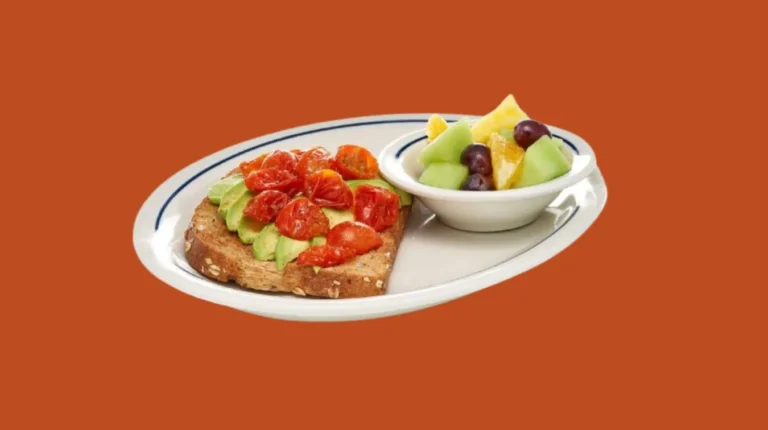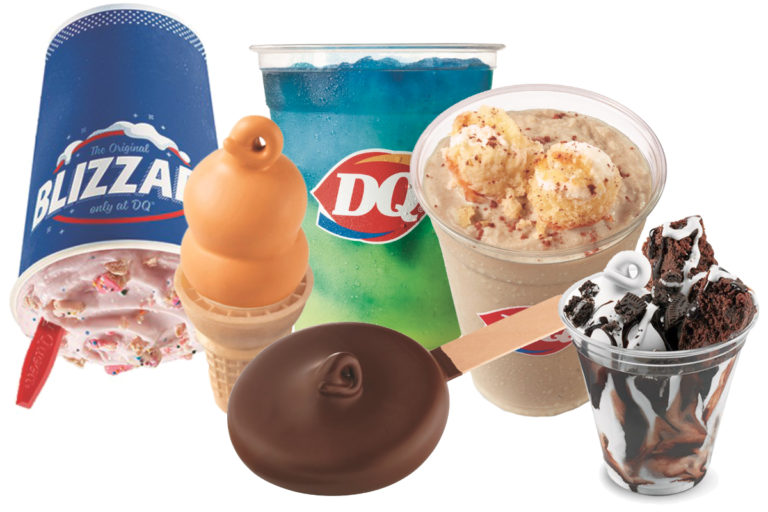How Many Calories Are In Ramen?
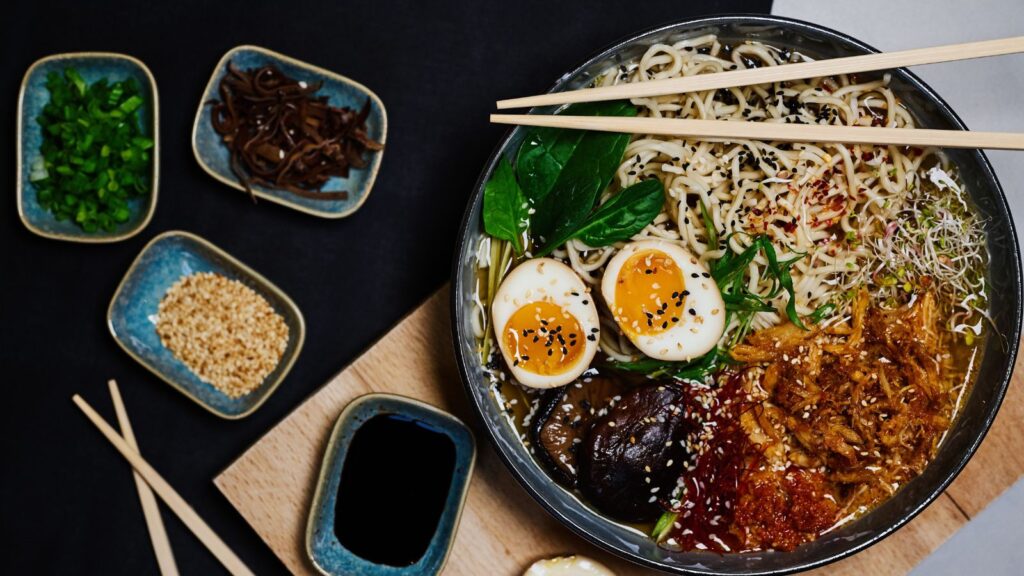
Are you wondering how many calories are in a bowl of ramen?
Ramen is a popular dish at Japanese restaurants that typically includes ramen noodles or wheat noodles, broth, beansprouts, mushrooms, eggs, soy sauce, miso paste, onions or shallots, chicken or beef, and seasonings like chili powder, ginger, garlic, sesame seeds, and soy sauce.
The number of calories in a bowl of ramen can vary greatly, making it difficult to figure out whether ramen is healthy or not!
Continue reading to find out how many calories are in a bowl of ramen, the calorie and nutritional information for different types of ramen, and tips on how to choose the healthiest ramen at a Japanese restaurant.
Calories in a Bowl of Ramen from a Japanese Restaurant
Ramen from a traditional Japanese restaurant made with wheat-based noodles and turkey or chicken usually has around 500-700 calories.
For example, the turkey ramen recipe from BBC Good Food has 656 calories, 16 grams of fat, 64 carbs, 7 grams of fiber, and 61 grams of protein.
However, a bowl of ramen from a Japanese restaurant may have up to 1,000 calories. The calorie content can vary greatly depending on the richness of the broth, the amount of oil used, and the toppings such as pork.
Takeaway: The number of calories in a bowl of ramen varies greatly. A bowl of ramen may have as little as 500 calories or up to 1,000 calories or more.
The number of calories in a bowl of ramen depends on
1) how large the bowl is,
2) how many noodles are in a bowl of ramen,
3) how much oil is used, and
4) the type of meat included (chicken vs. turkey vs. pork).
Lowest-Calorie Ramen Bowls at Japanese Restaurants
There are many different types of ramen available at Japanese restaurants.
Which ramen bowls are the healthiest and the lowest in calories?
Below are popular varieties of ramen with the estimated calorie information.
The main differentiator between each type of Japanese ramen is 1) the broth and 2) the protein (pork vs. chicken).
1. Vegetarian Ramen – 450 to 650 Calories Per Bowl
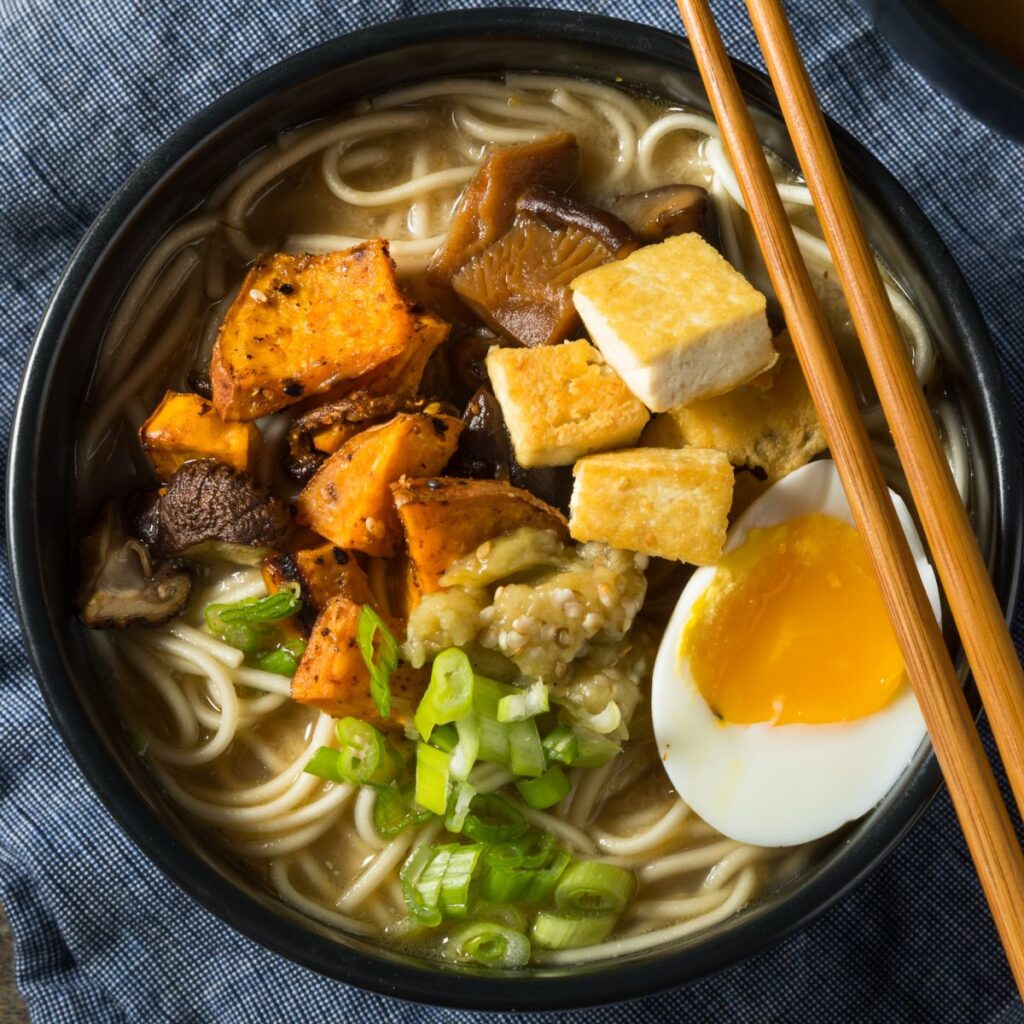
Vegetarian ramen from a Japanese restaurant typically includes vegetable broth, soy sauce, mushrooms, noodles, tofu, and Bok choy.
Because vegetarian ramen is made with no meat and with vegetable broth, vegetarian ramen is typically one of the lowest-calorie ramen bowls.
One serving of vegetarian ramen may have around 340 calories, which means one bowl of vegetarian ramen from a Japanese restaurant may have 450-650 calories per bowl (depending on the size).
2. Miso Ramen – 450 to 700 Calories Per Bowl
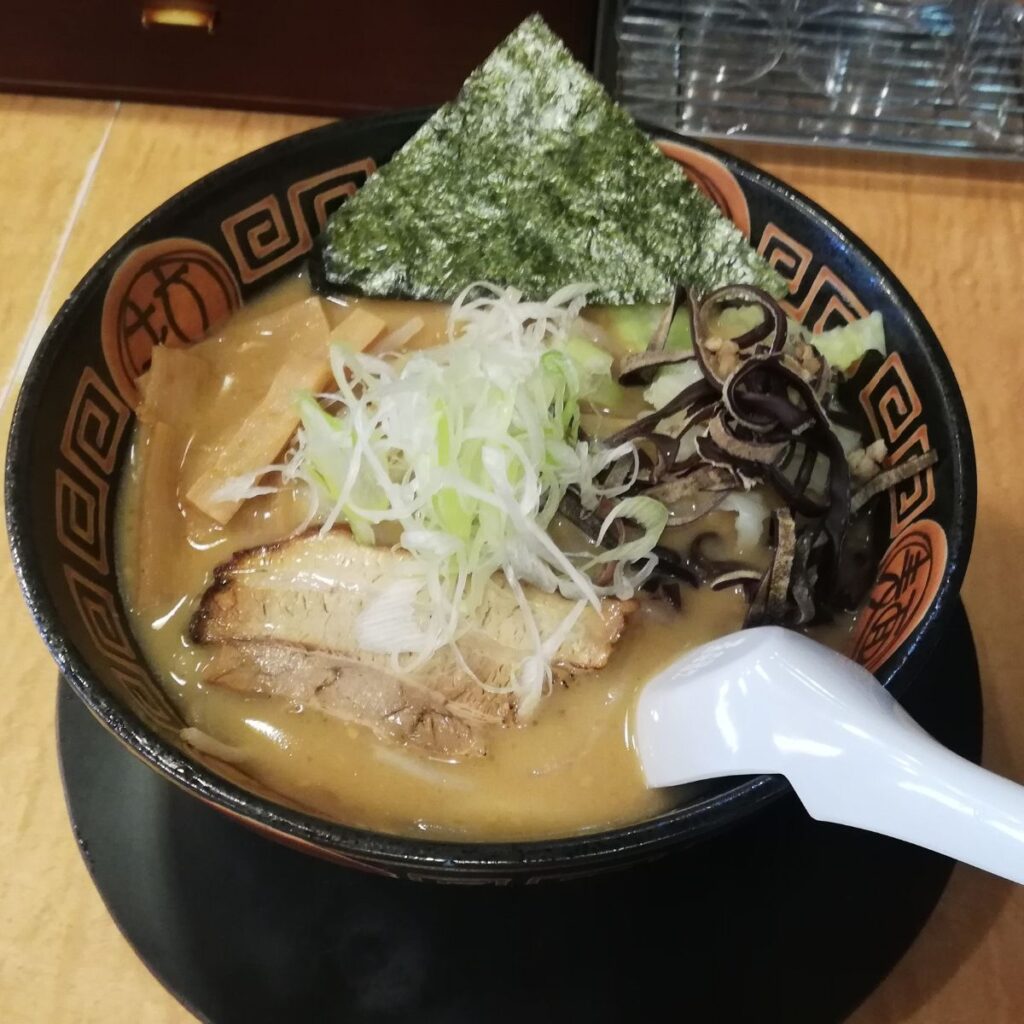
Miso ramen is a Japanese noodle soup made with a broth made from miso paste, hence the name “miso ramen.”
Miso ramen typically contains wheat noodles, sliced pork, eggs, tofu, seaweed, and scallions.
Like Shoyu ramen, the calories in miso ramen really depend on the serving size.
Miso ramen recipes list the calories as 430-490 calories per serving, which may equate to around 450-700 calories per miso ramen bowl.
3. Shio Ramen – 450 to 700 Calories Per Bowl
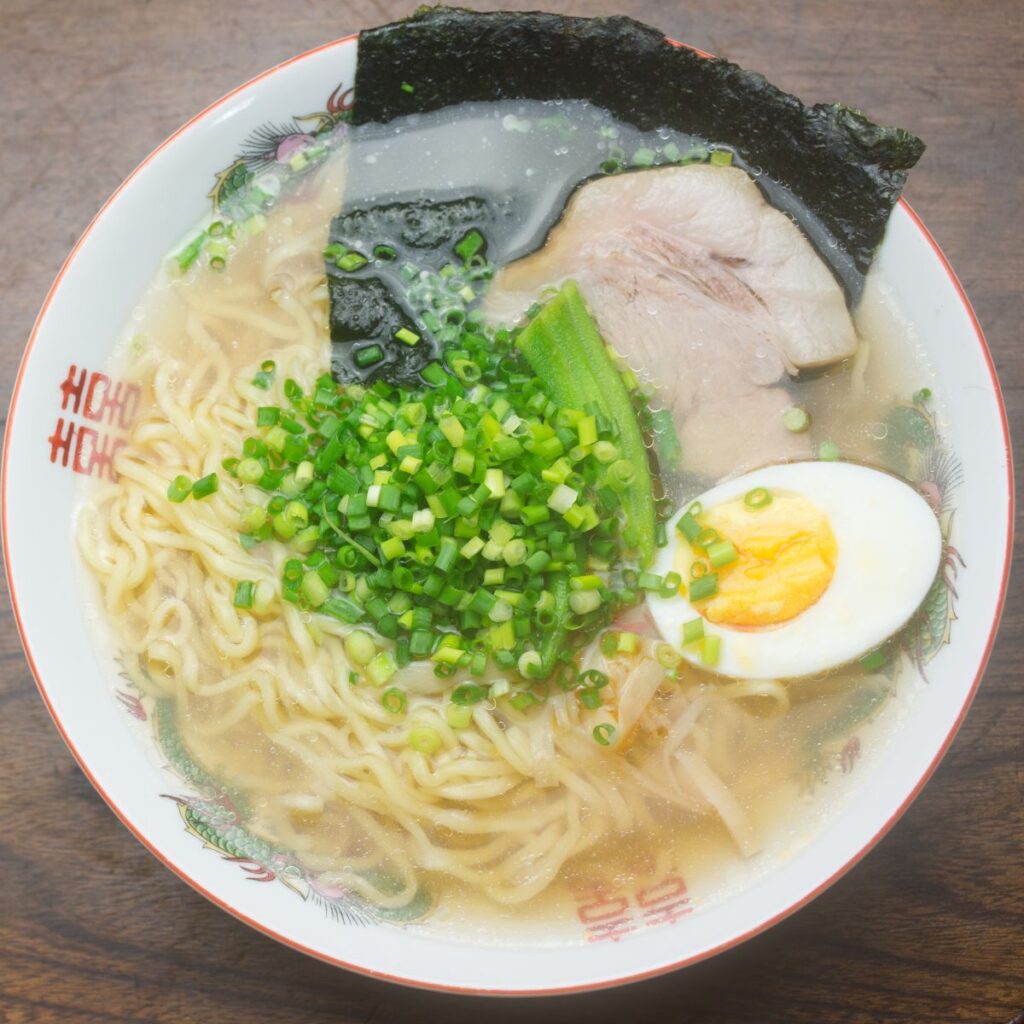
Shio ramen is made with clear chicken broth, noodles, bamboo shoots, chicken, and eggs.
Unlike Shoyu ramen and Miso ramen, Shio ramen is typically (but not always) made with chicken instead of pork.
Shio ramen has around 350 calories per serving, which may equate to 450 to 700 calories per bowl.
Fun Fact: “Shio” means salt in Japanese, hence the name “Shio ramen.”
4. Shoyu Ramen – 450-860 Calories Per Bowl
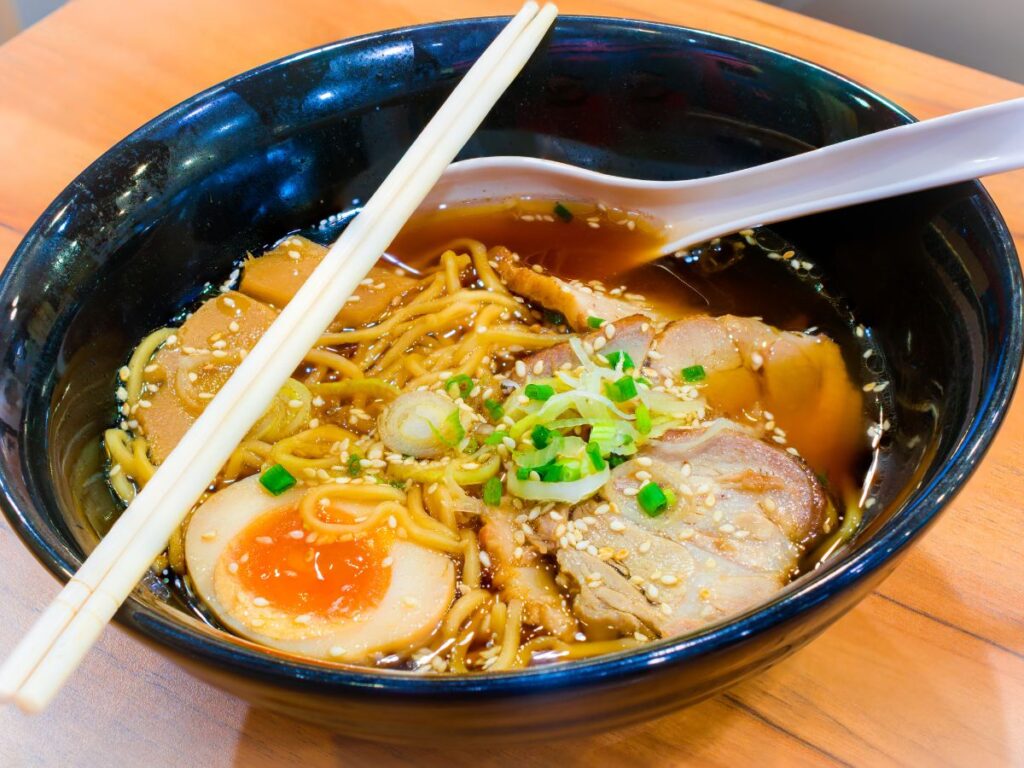
Shoyu ramen is made with wheat-based noodles, sliced pork, soy-based broth, green onions, nori (dried seaweed), mushrooms, soy sauce, and eggs.
Depending on the serving size and exact ingredients, Shoyu ramen may have up to 860 calories.
Fun fact: Shoyu means “soy sauce” in Japanese, hence the name.
5. Tonkotsu Ramen – 600 – 900 Calories or More Per Bowl
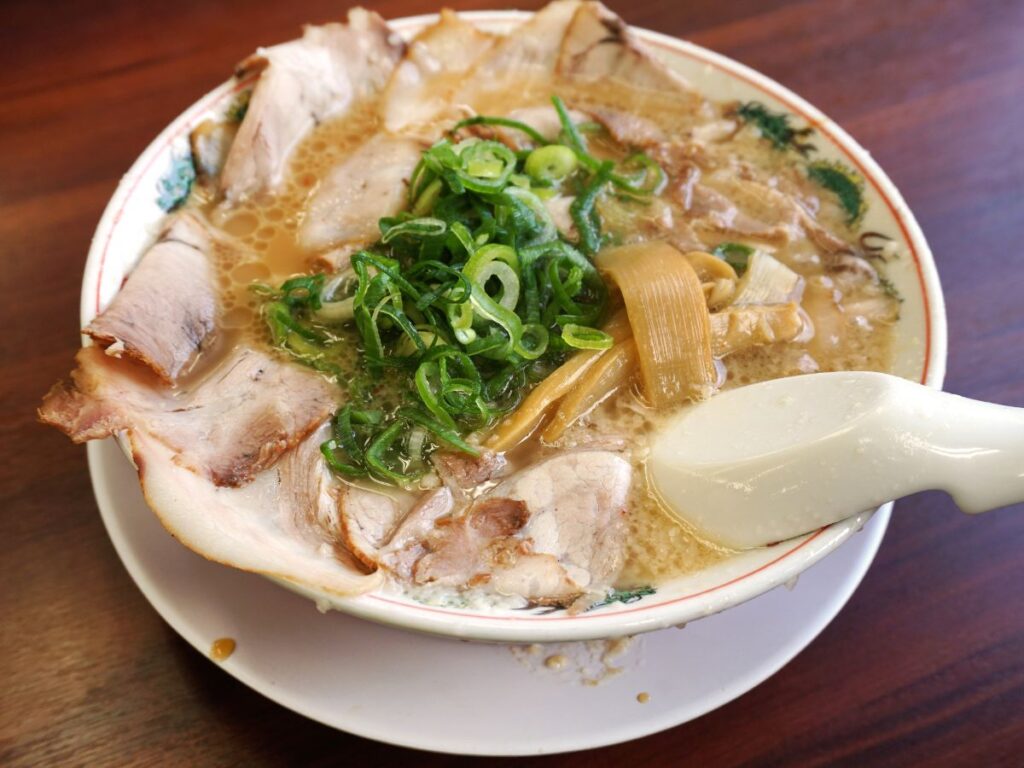
Tonkotsu ramen is a type of Japanese noodle dish made with pork bone broth, wheat-based noodles, sliced pork, green onions, nori (dried seaweed), egg, and tare (a seasoning).
Tonkotsu ramen has a creamy pork bone broth, which is simmered for hours until it develops a thick, milky consistency.
Because Tonkotsu ramen is made with a creamy broth, it is one of the higher-calorie Japanese ramen bowls.
On average, a Tonkotsu ramen bowl can range from 600 to 1,200 calories or more.
6. Curry Ramen – 570 to 900 Calories Per Bowl
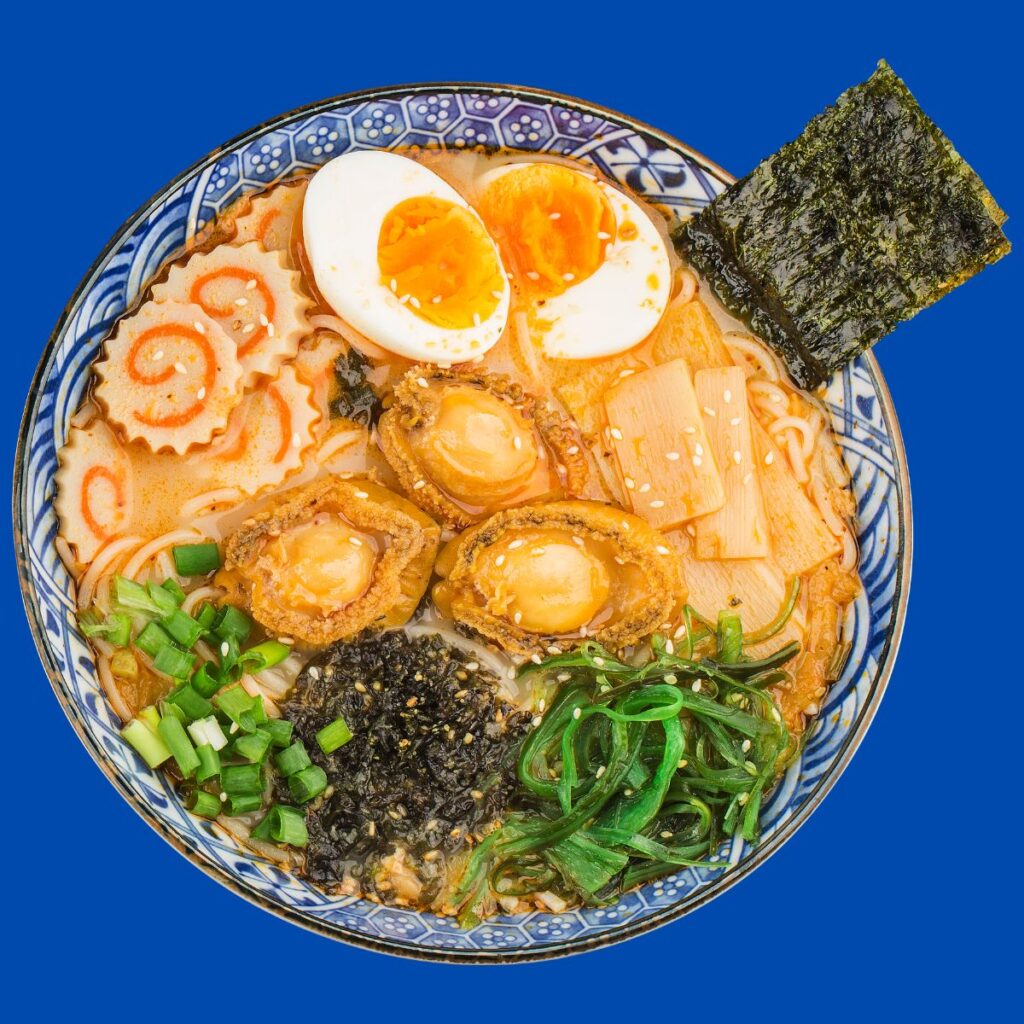
Curry ramen is a type of Japanese noodle dish made with Japanese curry and ramen (hence the name).
The ingredients in Japanese curry ramen include Japanese curry, wheat-based noodles, a protein such as pork or chicken, eggs, nori (dried seaweed), and seasonings.
Because ramen curry is made with a curry-based broth that includes coconut milk, curry ramen is relatively high in calories and fat.
The calories in curry ramen can vary greatly, but one estimate is 570 calories per serving, 34 grams of fat, 19 grams of protein, and 6 grams of fiber. This could equate to 570 to 900 calories per bowl, depending on the size.
Healthy and Low-Calorie Ingredients in Ramen Bowls
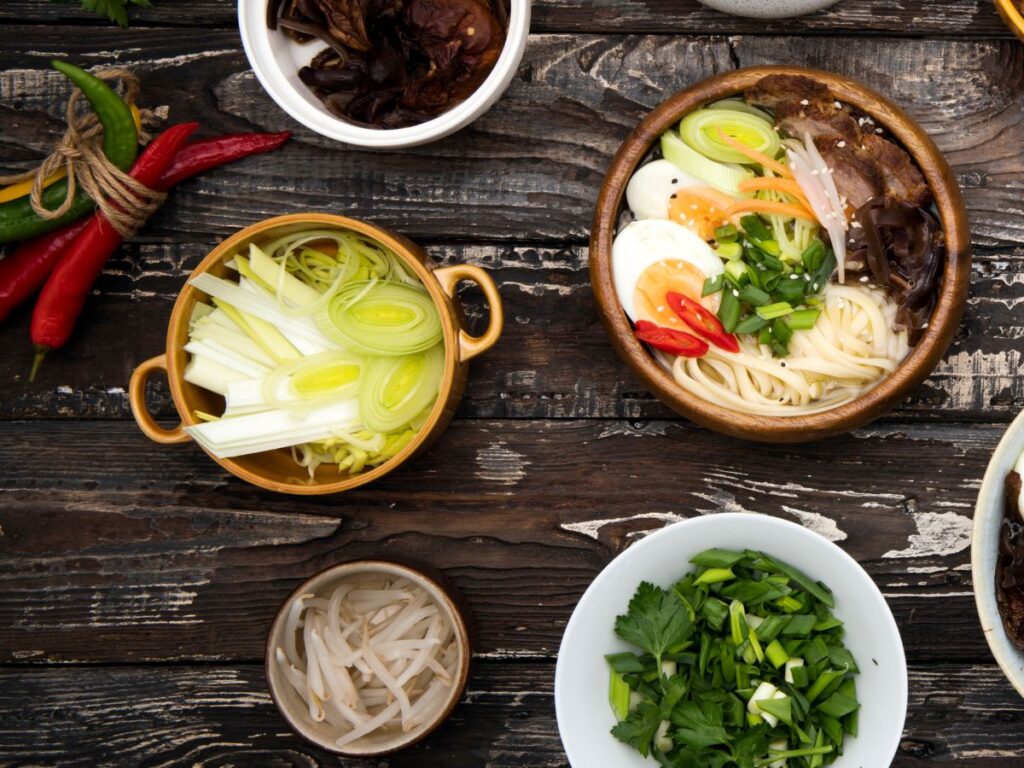
Many ramen bowls include low-calorie ingredients such as Bok choy, scallions, carrots, green onions, and mushrooms.
All these ingredients are low-calorie and healthy toppings for your ramen bowl.
How to Order a Healthy Bowl of Ramen at a Japanese Restaurant
If you want to order a healthy bowl of ramen at a Japanese restaurant, follow these tips.
1. Choose a Healthy Protein
Ramen bowls made with chicken, turkey, and/or eggs tend to have fewer calories than ramen bowls made with pork.
2. Choose a Low-Calorie Broth
Ramen bowls made with a pork-based broth have higher calories than ramen bowls made with a chicken broth or a vegetarian broth.
3. Avoid Ramen Bowls with “Curry” or “Creamy” in the Description
Ramen bowls with curry or cream likely have higher fat content and hence more calories.
4. Ask for More Vegetables
If possible, ask your server if the restaurant can make your ramen bowl with more vegetables and fewer noodles.
You may also want to order another dish at a Japanese restaurant instead of ramen if you are trying to lose weight and/or eat healthily.
Check out these healthy foods to order at a Japanese restaurant.
Japanese Ramen Noodles vs. Ramen Noodles
Both Japanese ramen and ramen noodles sound alike, but they are quite different!
Japanese Ramen Noodles
Japanese ramen refers to a traditional Japanese noodle dish that is made with wheat-based noodles, broth, protein, vegetables, and seasonings such as soy sauce, miso, chili oil, and garlic.
Ramen
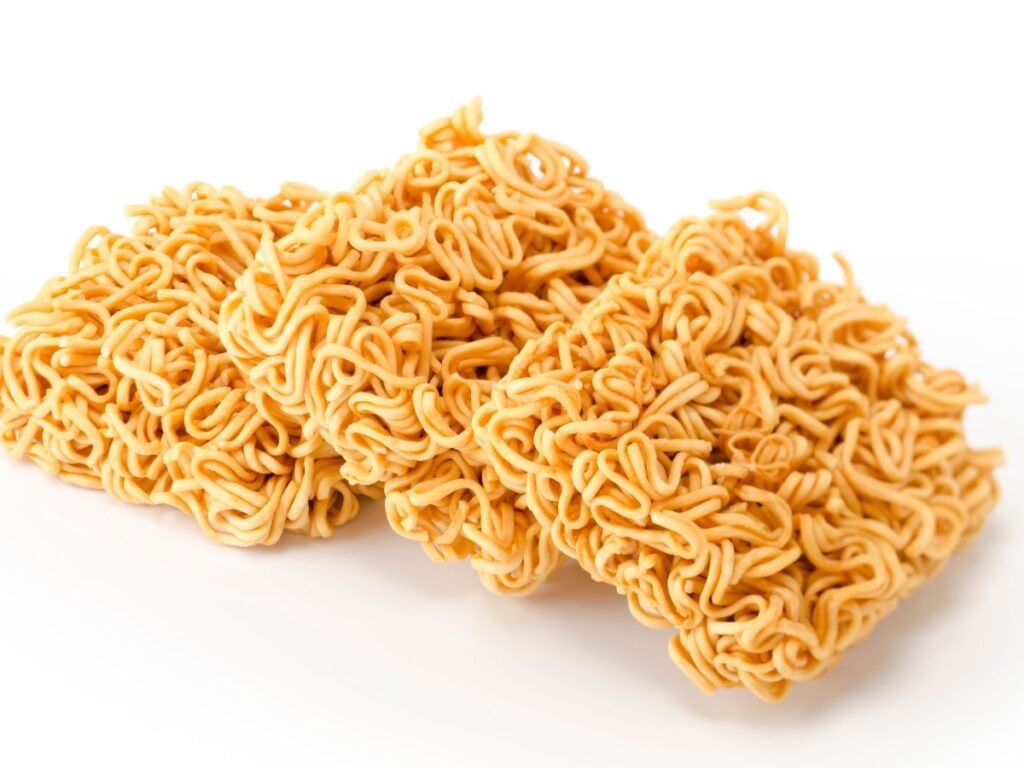
In contrast, ramen noodles refer to the dried, packaged noodles that are sold at grocery stores like Kroger and Amazon Fresh.
Ramen noodles are typically sold in a block of dried noodles and packaged in plastic packaging. To make ramen noodles at home, you simply boil water at home and let the noodles seep for 3 minutes to make instant ramen.
Calories in Maruchan Ramen
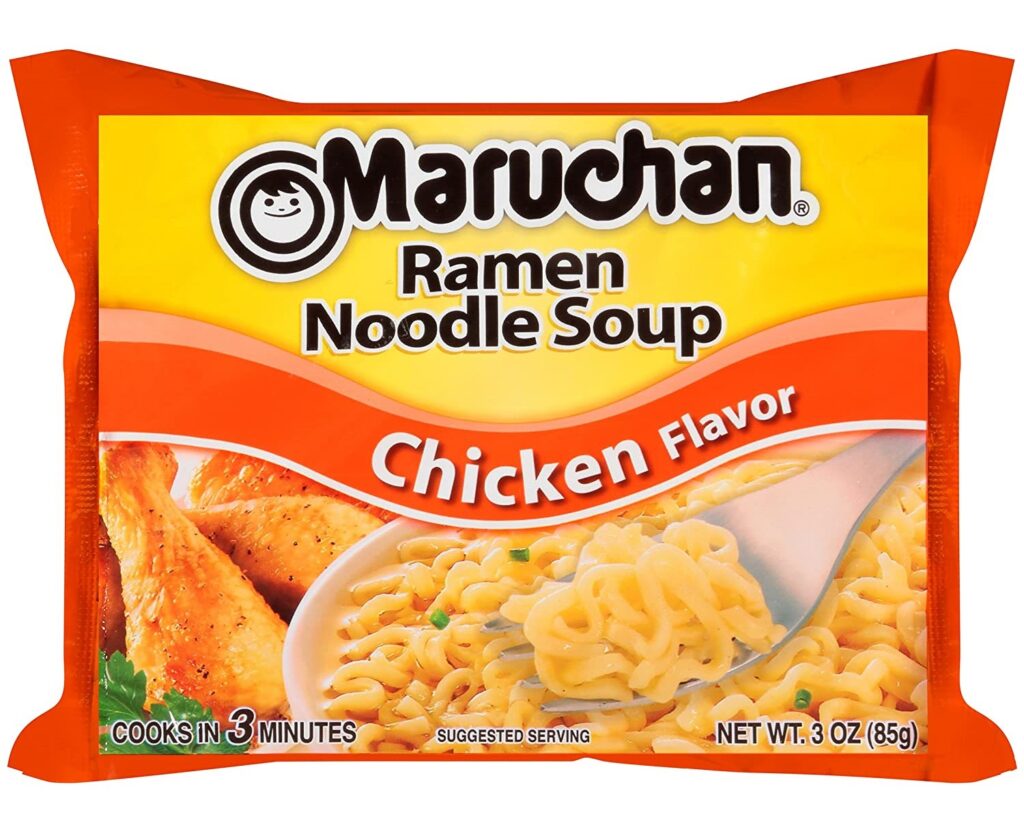
If you love having instant ramen at home, you have likely heard of Maruchan Ramen.
Maruchan Ramen comes in packets so that you can easily make ramen noodle soup at home. You simply boil 2 cups of water, add the ramen, wait 3 minutes, and then – voila! – you have ramen noodle soup.
Maruchan ramen is tasty, but it is also high in sodium, high in saturated fat, and relatively low in dietary fiber and protein.
In general, Maruchan Raman is not a very healthy option if you are looking to eat healthily. Maruchan Ramen contains over 1,000 mg of sodium, is low in fiber and contains little to no nutrients.
Below is the nutritional information for one packet (3 oz) of Maruchan Ramen Noodle Soup in popular flavors.
- Chicken Flavor Maruchan Ramen Noodle Soup – 380 Calories, 14 Grams of Fat, 8 Grams of Protein
- Beef Flavor Maruchan Ramen Noodle Soup – 380 Calories, 14 Grams of Fat, 8 Grams of Protein
- Pork Flavor Maruchan Ramen Noodle soup – 380 Calories, 14 Grams of Fat, 10 Grams of Protein
- Shrimp Flavor Maruchan Ramen Noodle Soup – 380 Calories, 14 Grams of Fat, 8 Grams of Protein
Source: Nutritional Information from Maruchan Ramen Noodles
Why is Ramen High in Calories?
Ramen can be high in calories due to several factors.
Below are reasons why ramen can be high in calories.
- Noodles: Ramen noodles can be high in calories and low in fiber.
- Broth: Chicken and vegetable broth is relatively low in calories, but ramen dishes made with high-fat ingredients like pork bones can add extra calories.
- Toppings: Fried vegetables or fried tofu can add extra calories to ramen.
- Protein: Sliced pork can be high in calories if used in a ramen bowl.
- Portion size: A bowl of ramen may be quite large, contributing to a higher calorie count.
In summary, ramen can be high in calories due to the type of noodles used, the broth, the toppings and protein, and the portion size.
Is Ramen High in Fat?
Ramen can be high in fat depending on the broth and on the type of meat used.
A traditional bowl of Japanese ramen may be high in fat if it contains sliced pork, a pork-bone-based broth, a curry broth, and/or oil.
Instant ramen noodles contain 14 grams of fat per package, which is about 40% of your daily value. Instant ramen noodles also contain 12 grams of saturated fat, which is 60F of your daily value.
Is Ramen Healthy for Weight Loss?
Ramen, like many foods, can be healthy or unhealthy depending on the ingredients used and how it is prepared. A traditional bowl of Japanese ramen is made with whole-grain noodles, broth, vegetables, lean protein, and spices.
Ramen made at home can be healthy for weight loss, but it is important to be mindful of the calorie information. If you are trying to lose weight, a bowl of ramen with 700 or more calories may be more calories than ideal.
For healthier lunch options, check out these lunches under 300 calories and these lunches under 400 calories.
More Healthy Eating & Weight Loss Guides
How to Eat Healthy at Popular Restaurants
Please Share the Love and Connect with The Jeans Fit!
Did you find this article helpful? Please give it 5 stars (see below!) and share this article with a friend via Facebook and Twitter.
I’d also love you (more than a chocolate sundae!) if you connect with me on social media. You’ll be doing this gal who’s trying to start her fitness blog a big favor. Karma, right? 😊
Connect with The Jeans Fit on Instagram
Subscribe to The Jeans Fit YouTube channel
Like The Jeans Fit on Facebook
Have a great day!
Chrissy from The Jeans Fit
